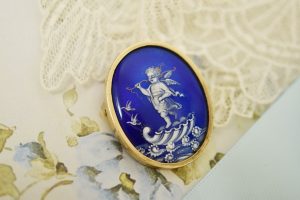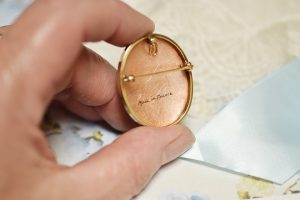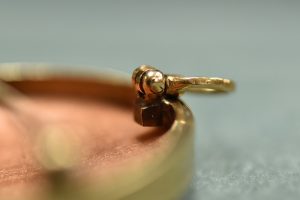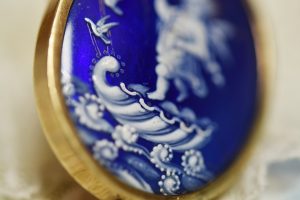Joden Girl
Baubles, Bling and Pastiche Things
One of the most interesting things I do (or attempt to do) for each blog is research. Sometimes it’s rewarding, but often it’s frustrating. Each era is characterized by prominent themes, choice of metal, gemstones utilized and the defining details that set those years apart from all others. These particulars are a good place to begin. Studying the object at hand, I tick off the boxes of my mental checklist…
- Yellow gold frame
- Cobalt blue enamel
- “Made in France” written on the back side
- Foldover bail
- 20th century pin catch


There are no hallmarks and no gold stamp. Lucky for me, we have a Thermoscientific Metal Analyzer (a small x-ray machine) that gives a very specific listing of the elements contained in the metal. I carefully placed the shiny golden edge of the frame over the eye of the analyzer and closed the lid. The little computer cycled for about 30 seconds and then showed the result – in this case, the gold purity read 14-karat. It wasn’t until about 1890 that 14-karat gold came into being… prior to that, higher karat gold (like 18-karat) was the standard.
After testing the gold purity, I tested the blue enamel on the front of the piece. The results contradicted my other findings. The analyzer revealed that the enamel is 97% lead, with less than 1% each of gold, zinc, copper, cobalt, and iron. Gently flipping the brooch over, I tested the shimmery copper-colored enamel on the back side. The results were quite similar. The screen read 95% lead, 2.3% platinum and less than 1% each of silver, zinc, copper and iron.
Enamels made during the Renaissance period (14-17th century) had significant amounts of lead combined with opacifiers (substances that made the enamel opaque). Small amounts of other metals were added as colorants – like cobalt to create blue enamel. Enamels from the 18-19th century have a lead, potassium and silicon base; however, there were a few enamelists who continued to use traditional (heavily lead-based) enamels well into the 19th century. Nothing about this brooch seems to make sense.


As I mentioned early on, this brooch has a “locking C” clasp. This round-hinged clasp did not appear in jewelry before the 1920’s and 1930’s. In fact, this type of pin catch is still widely used today. Close inspection reveals that these modern elements – the pin hinge, clasp, and foldover bail were actually soldered onto part of an older structure. They’re definitely not original to the piece.


My findings present a conundrum… 14-karat gold wasn’t used until the turn of the century. Additionally, since 1838, all gold jewelry sold in France is tested and marked with an eagle’s head. 18-karat is the minimum purity that jewelry must be in order to be evaluated and appraised. The enamel used has a high concentration of lead, another indicator of an early piece. Finally, the pin stem, catch and bail were changed sometime after 1920. Perhaps the enameled centerpiece was made during the Renaissance era and was remounted later on. Or perhaps the entire piece was made at a later time by an enamelist who continued to use lead-based enamel.
While we cannot ascertain any of these possibilities, what we do know is that this brooch is quite lovely. The iridescent background is a glorious shade of royal blue. The image (done almost entirely in opaque white enamel) rises slightly off the surface. A winged cherub rides atop of the curl of a conch shell with a golden staff clutched in his right hand. A pair of doves fly along beside him. There are many potential inspirations for this piece…
- Cupid riding on a dolphin
- Galatea escaping Polyphemus
- Venus and Cupid in a Shell
- Cupid being led by tortoises
Each one of these famous images bears similarities to our vintage beauty. It could be any one of them, or none of them. Customers are always asking us where we get our treasures, who owned and wore them. The truth of the matter is, we almost never know. An although I love playing detective and piecing clues together, the mystery of this brooch remains. Originally priced at $1980.00, it’s available now for just $1600.00. If you’re as charmed by the mystique of this piece as we are, call us to claim it for yourself.

“You can go to a museum and look, or come to us and touch.”
Written by Carrie Martin
Photos by Dana Jerpe
